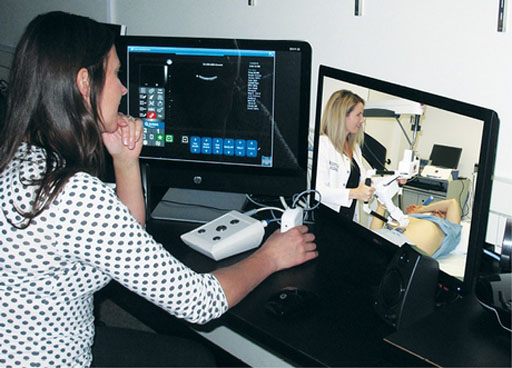Telerobotic Ultrasound to Enable Remote Provision of Professional Care to Patients
By MedImaging International staff writers
Posted on 27 Dec 2016
The University of Saskatchewan has released the results of a study intended to assess the use of telerobotic ultrasound to enable sonographers and radiologists to perform exams remotely.Posted on 27 Dec 2016
The researchers assessed whether the system was able to generate diagnostic-quality images, and whether the telerobotic ultrasound workflow was acceptable to sonographers and patients.

Image: The study showed that telerobotic ultrasound could enable sonographers and radiologists to perform exams remotely (Photo courtesy of RSNA).
Scott J. Adams presented the results of the study at the annual Radiological Society of North America Annual Meeting (RSNA 2016). The researchers used a standardized abdominal imaging protocol for the study, which included 18 patients. They first carried out conventional sonography and then repeated the exams using telerobotic ultrasound. The sonographer used a videoconferencing system and a non-dedicated Internet connection to scan the patients during the remote exam.
The assistant who guided the gross movements of a robotic arm based on the instructions received from the remote sonographer at the patient site, had no healthcare background and no ultrasound experience. The remote sonographer used a mock probe and touchscreen monitor that showed the ultrasound interface and enabled remote control over all settings and movement of the transducer.
Results showed that the sonographer could visualize 92% of the organs sufficiently from the remote site in comparison to using conventional sonography. The researchers also carried out a paired sample t-test that showed no significant difference in measuring the spleen, liver, and diameter of the proximal aorta, when using the two modalities. In addition, all patients were willing to undergo another telerobotic examination in the future and were comfortable communicating with the sonographer using video conferencing system.
Scott J. Adams, University of Saskatchewan College of Medicine, said, "Telerobotic sonography may facilitate routine studies, after-hours sonography for emergent cases, or access to subspecialized sonography which would otherwise not be available. The average duration of the telerobotic examinations was longer than that of conventional examinations, though the duration continued to decrease as sonographers gained experience using the telerobotic system. We believe a network of remote US clinics will fill an unmet need in providing timely access to ultrasound services in rural, remote or low-volume centers."
Related Links:
AdEchoTech














